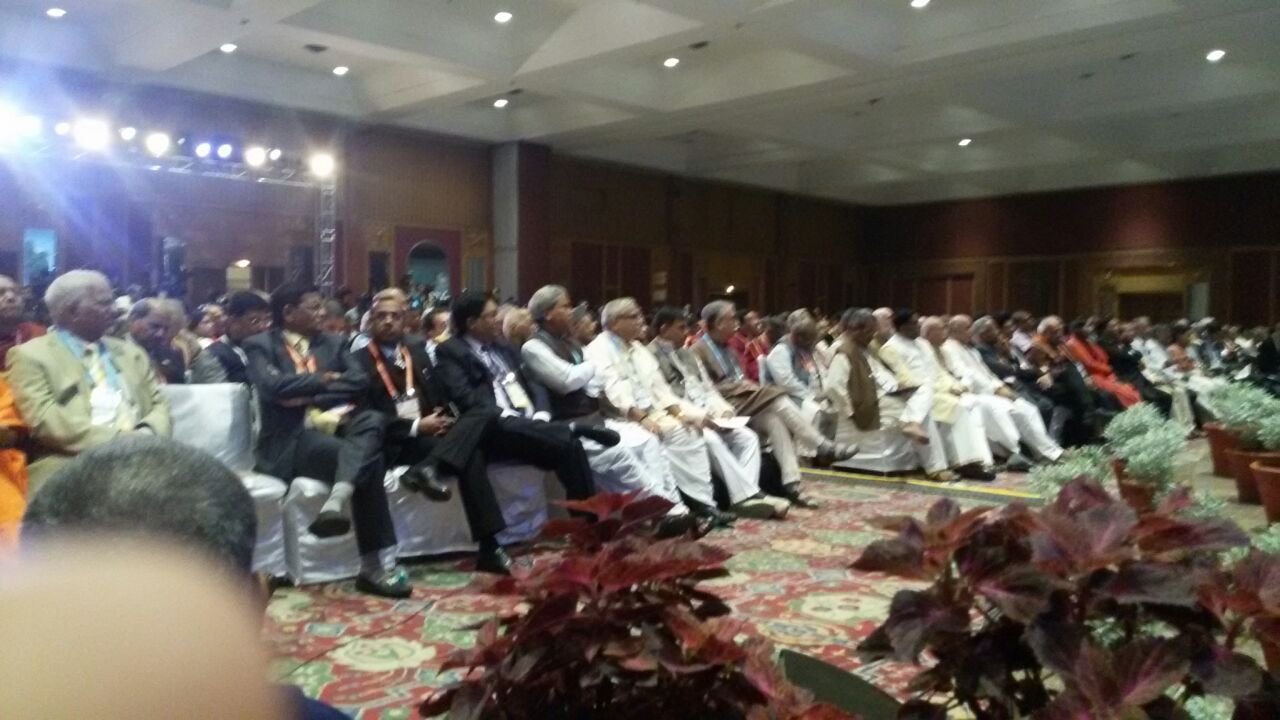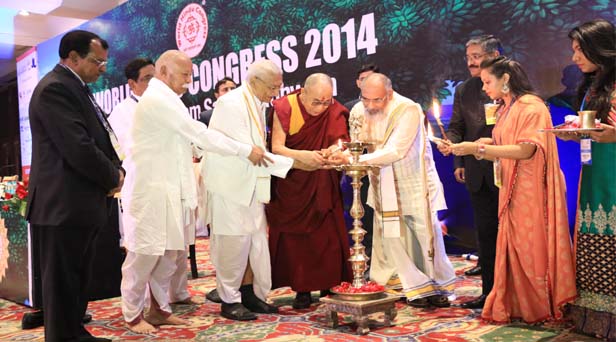(The World Hindu Congress of 21-23 November 2014 in Delhi, an achievement by Swami Vigyananda, compares favourably with other similar initiatives, being more focused and free of compromise with secularism. It offered a taste of what an unfettered Hindu society in normal non-Nehruvian circumstances could be. One of the seven conferences was the Organizational Conference, which concluded with a panel debate. As another speaker had cancelled, I was asked to improvise an intervention. On the basis of impressions gathered at the congress and in informal talks in the lobby, I presented the following observations.)
 One has to be in sympathy with the small minority of Hindus who like to pin-prick the hollow optimism typical of the RSS. This organization likes to style itself as the vanguard of Hindu revival, but has not stopped Nehruism and the decline of Hinduism. On the contrary, it plays by the rules laid down by its enemies. The commitment to Hinduism is subordinate to the eagerness for mere trinkets, such as the shine of secularist approval, a prize dangled before pliant Hindutvavadis but never really given.
One has to be in sympathy with the small minority of Hindus who like to pin-prick the hollow optimism typical of the RSS. This organization likes to style itself as the vanguard of Hindu revival, but has not stopped Nehruism and the decline of Hinduism. On the contrary, it plays by the rules laid down by its enemies. The commitment to Hinduism is subordinate to the eagerness for mere trinkets, such as the shine of secularist approval, a prize dangled before pliant Hindutvavadis but never really given.
Many Hindus like to boast how good Hindus are at making money, how they are the richest immigrant community in the US, but it always proves very difficult to amass funds for Hindu causes. And when they are available, they are squandered on luxuries rather than on substance. It is therefore quite an achievement to get this WHC on the rails, an event that has paid its own way thanks to the registration fees paid by some 1800 participants. The present successful achievement is but one of several signs of hope.
Tamas
 At Hindu gatherings I attended during the past few decades, the atmosphere was distinctly “tamasic”. This is a concept from Hindu cosmology, where it is one of the three elements in a tripolar model of the universe.
At Hindu gatherings I attended during the past few decades, the atmosphere was distinctly “tamasic”. This is a concept from Hindu cosmology, where it is one of the three elements in a tripolar model of the universe.
The three are (1) sattva, the light and transparent pole, (2) rajas, the dynamic and passionate pole, and (3) tamas, the dark and heavy pole. Tamas means inertia, passivity, slothfulness, confusion and resistance to innovation. It is not so good at action, but very resourceful at inventing excuses for inaction.
That was till recently the dominant mood at Hindu gatherings. There was endless wailing about what the enemies did to Hindus, but no plans were devised, let alone implemented, to remedy these injustices. There were also conspiracy theories, the wilder the better, to explain why the enemies were both evil and powerful, so much so that the thought of countering them did not even arise. Incidentally, a mirror-image of these conspiracy theories is the strawman that the secularists make of the Hindu movement: to their captive audiences, such as the consumers of the mainstream media or the Western donors of the Christian mission: they feed the lie that Hindu activism is evil, powerful and diabolically clever. The use of this untruth is that it can present any anti-Hindu action as brave and any anti-Hindu oppression as necessary.
 But the difference is that they understand the difference between lies for public consumption and their private knowledge that Hindu activism is but a paper tiger. Hindu activists, by contrast, believe in their own conspiracy concoctions.
But the difference is that they understand the difference between lies for public consumption and their private knowledge that Hindu activism is but a paper tiger. Hindu activists, by contrast, believe in their own conspiracy concoctions.
Thus, even at the otherwise stimulating media section of this congress, the forward-looking atmosphere was tainted only by a cursory remark premised on the canard that the foreign media are acting out a highly motivated anti-India strategy explaining their glaring bias and hostility. In reality, the foreign media have no stake in India and don’t care one way or another. Their partisan reporting results from the partisan information they are fed by their secular sources in Delhi, who control the narrow bottleneck of information about India. This news monopoly has existed for decades and for all this time, it was tolerated and passively perpetuated by the Hindu forces.
Witness the tamasic implication of conspiracy theories: they justify and stimulate passivity. If the enemy is wily and all-powerful, it is no use trying to counter him, and effectively, Hindus have not bothered to combat the secularist dominance in the mainstream media. Similarly, the very false but very common belief that the Partition of India resulted from a British conspiracy. and not from the application of Islam’s political doctrine to the then Indian situation, relieves Hindus of the difficult task of analyzing Islam as a factor of anti-India and anti-Hindu policies. This way they, along with the secularists, can perpetuate the delusion that Islam is OK, that Hindus and Muslims have always been brothers only separated by a colonial ‘divide and rule” policy, and that India’s current problems with Pakistan are due to external factors, such as the influence of the evil Americans, who count as the secret puppeteers behind Islamic terrorism.
Against all these mysterious forces with their hostile agendas, no serious resistance is possible, and hence the Hindu activists have never organized one. Or have they?
The new media
At this congress, a different sound was heard. In the media conference, so-called “internet Hindus” have been reporting how their use of the social media has bypassed and outwitted the MSM dominated by anti-Hindu voices. Facts are reported through alternative channels and break through the curtain of silence about inconvenient information. Many a time, the MSM are forced to react to knowledge that has turned out to be common among the public, eventhough they had at first tried to keep the lid on it.
Opinion is being created through twitter messages. They are tailor-made for a generation with a short attention span, and hence far more effective than newspaper articles. They also generate quick and exciting exchanges of opinion. These twitter debates are very successful at giving the public a gist of the opinion spectrum that exists relative to a specific issue. They might not be as thorough as an in-depth article, but they certainly outdo the one-sided articles that make it through the censorship sieve of the MSM.
The new media have played a decisive role in winning over the new generation to the Narendra Modi campaign. That Modi won is admittedly a victory, but we should not lose sight of the old-style struggle that made it possible. For twelve years, Modi has had to struggle against an enormously mean secularist campaign of defamation, inducing even an anti-Modi intrigue within the BJP. Only a year ago, the BJP leadership tried to thwart Modi from becoming the Prime-Ministerial candidate. It is when this old-style struggle had been won, that the struggle for national electoral victory started and the adroit use of the new media made a difference. So, while the BJP’s media team has an achievement to be proud of, we should keep in mind the over-all context, where the secularists have not disarmed and their usual viciousness will certainly come to plague us again. Our newly acquired skills will be needed.
Corruption
 A pervasive form of tamas in society is corruption. It acts like a parasite, eating away at the vitality of a society, and at its capacity to act. In the main, the success of the present Hindu government will be measured by its capacity to curb corruption. It must not only effect a conjunctural dip, but a structural remedy. In miniature form, this very congress can serve as an acid test.
A pervasive form of tamas in society is corruption. It acts like a parasite, eating away at the vitality of a society, and at its capacity to act. In the main, the success of the present Hindu government will be measured by its capacity to curb corruption. It must not only effect a conjunctural dip, but a structural remedy. In miniature form, this very congress can serve as an acid test.
At Hindu conferences I attended in the 1990s, quite a few worthless papers were the result of the following corrupt practice. The organizers, starved for money, accepted contributions from sponsors in exchange for the honour of presenting a paper. In the present case, the organizers were approached several times for this kind of deal, but they refused. Papers had to stand by virtue of their own merits, not by virtue of the funds attached to them.
This awakening to the need of more integrity and more purposeful action is part of a larger pattern set by politicians like erstwhile Kashmir Governor Jagmohan, former Minister of Disinvestment Arun Shourie and former Gujarat Chief Minister Narendra Modi: to cut through the vested interests and not to let them sap the energies of society. All three have been have been criticized by the secularists as paragons of Hindutva. Indeed, we have it on the authority of the secularists that those whom we know as men of integrity and as spectacularly good administrators, are “rabid communalists”, while the opportunists and time-servers whom they call “moderates”, are practitioners and upholders of corruption.
Long live dynamism!
 Following this pattern, we see that the effective leadership of the World Hindu Council (VHP) is now exercised by man who is both impeccable and a reputed Hindu radical. Swami Vigyananda is a veteran of the Babri Masjid demolition on 6 December 1992, as well as a dynamic organizer with a modern outlook and a remarkable skill in means, an ease in doing things.
Following this pattern, we see that the effective leadership of the World Hindu Council (VHP) is now exercised by man who is both impeccable and a reputed Hindu radical. Swami Vigyananda is a veteran of the Babri Masjid demolition on 6 December 1992, as well as a dynamic organizer with a modern outlook and a remarkable skill in means, an ease in doing things.
So, he had the foresight to visualize the present congress, which he announced five years ago, and which happens to coincide with the first Hindu government in Delhi since 1192. (Well, I’ll grant you Hemachandra in 1556, but his rule lasted only a few weeks, until the proverbially enlightened Moghul emperor Akbar had him beheaded.)
The window of opportunity opened by Modi’s victory will not last forever. We must use it to effect the needed changes in the Indian polity.
This very congress, very well-organized as you all have noticed, and with a preponderance of high-quality papers, proves that Hindus manage to outgrow their tamasic pattern. Correspondingly, the mood is upbeat and creative. There are successes to report and more to come. Down with the despondency of the past decades! Long live the self-made Hindu spirit of achievement!


























